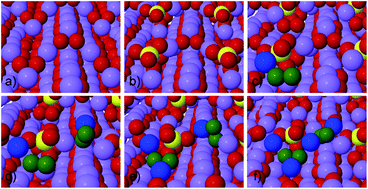Selective poisoning of Li–air batteries for increased discharge capacity
Abstract
The main discharge product at the cathode of non-aqueous Li–air batteries is insulating Li2O2 and its poor electronic conduction is a main limiting factor in the battery performance. Here, we apply density functional theory calculations (DFT) to investigate the potential of circumventing this passivation by controlling the morphological growth directions of Li2O2 using directed poisoning of specific nucleation sites and steps. We show SO2 to bind preferentially on steps and kinks on the (1−100) facet and to effectively lower the discharge potential by 0.4 V, yielding a more facile discharge on the (0001) surface facet. Addition of a few percent SO2 in the O2 stream may be used to control and limit growth of Li2O2 in specific directions and increase the electronic conduction through formation of interfaces between Li2O2 and Li2(SO2)-type inclusions, which may ultimately lead to an increased accessible battery capacity at the expense of a limited increase in the overpotentials.


 Please wait while we load your content...
Please wait while we load your content...